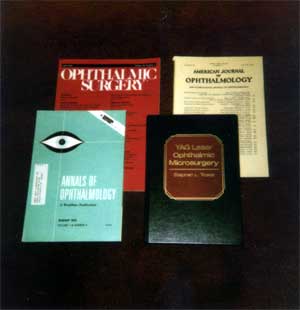
A search through our hospital library, Med-Line source, and the National Library of Medicine reveals only five papers in the literature on treatment of vitreous floaters. They are listed below. The total number of floater cases reported is 60.There were no serious complications in any of the floater disruption cases. Only the Aron-Rosa paper has long term follow-up. In that paper there were no late onset complications. Doctor Karickhoff's book is the only one that has been written on the subject of laser treatment of vitreous floaters.
Neodymium: YAG laser vitreolysis
Aron-Rosa, Daniele "Neodymium: YAG laser vitreolysis", Int. Ophthal. Clinics 1985 25:125-134
At the time of the paper 8,500 patients had been treated in their clinic with the YAG laser. However, only 50 had 3-4 year follow-up and these were presented in the paper.Any patient having a retinal hole preoperatively was treated with the argon laser 3 to 6 days before the YAG treatment. Seven of the 50 patients were treated for floaters. Of these there was one case of transient intraocular pressure rise, and one case of transient vitritis.There was no development of cataracts, retinal holes or detachments in the 50 patients in spite of most of the 50 patients were treated heavily for vitreous membranes near the retina. She stressed the importance of using a magnifying contact lens for the surgery.
Vitreolysis with the Q-switched laser
Fankhauser, Franz "Vitreolysis with the Q-switched laser" Arch Ophthalmology 1985 103:1166-1171
Dr. Fankhauser is considered the founder of the laser treatment of floaters.His paper consists of mainly cutting vitreous membranes, but there are 10 cases of floater disruption. There were no complications.
Q-Switched neodymium: YAG laser surgery of the vitreous
Little, H. L. "Q-Switched neodymium: YAG laser surgery of the vitreous" Graefe's Arch Clin Exp Ophthalmol 1986 224: 240-246
This study of 59 cases included 25 cases of vitreous opacities. Other cases were of vitroretinal band and membranes. No complications were listed for the treatment of vitreous opacities cases. They used a modified Coherent model 9900 laser. He stresses the importance of using contact lenses with magnification.
Indications for Q-switched and mode-locked Nd:YAG lasers in vitreoretinal pathology
Tassignon, MJ "Indications for Q-switched and mode-locked Nd:YAG lasers in vitreoretinal pathology", European Journal of Ophthalmology 1991; vol. 1/no. 3: 123-130
This is a comparison of the two laser types mainly for cutting vitreous membranes. The treatment of 3 floaters, all severe, was reported.The Q-switched laser was used. All cases were successfully treated and there were no complications reported.
Treatment of vitreous floaters with neodymium YAG laser
Tsai, Wu-Fu "Treatment of vitreous floaters with neodymium YAG laser", British Journal of Ophthalmology 1993; 77:485-488
This is the only report in the literature containing only treatment of vitreous floaters cases. It reports 15 cases of obliteration of vitreous floaters with the Lasag Microruptor III YAG laser. All cases were successful and there were no complications. Patients were chosen because the floaters caused psychological symptoms. 13 of their cases had a PVD.
